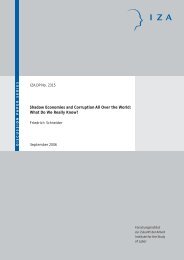Limited Self-Control, Obesity and the Loss of ... - Index of - IZA
Limited Self-Control, Obesity and the Loss of ... - Index of - IZA
Limited Self-Control, Obesity and the Loss of ... - Index of - IZA
Create successful ePaper yourself
Turn your PDF publications into a flip-book with our unique Google optimized e-Paper software.
greater probability. Consistent with this, people who care about <strong>the</strong>ir diet are less likely to be<br />
obese, with a risk ratio <strong>of</strong> 0.81 relative to people who do not care.<br />
[Table 2 about here]<br />
Estimation C presents correlations between reported obstacles to a healthy diet <strong>and</strong> body<br />
mass. The relative risk ratios <strong>the</strong>reby need to be interpreted with caution. Social desirability<br />
<strong>and</strong> self-justification might well distort some <strong>of</strong> people’s self reports <strong>and</strong> thus measured<br />
correlations. However, in estimation C, all <strong>the</strong> survey items are jointly included <strong>and</strong> not all<br />
items are equally attractive in justifying overweight or obesity. Five obstacles to a healthy diet<br />
are found to be statistically significantly related to a respondent being obese: not enough<br />
choice in shops, <strong>the</strong> relative cost <strong>of</strong> healthy food, not enough support from o<strong>the</strong>rs, strong<br />
preference for good food, <strong>and</strong> lack <strong>of</strong> will power. While <strong>the</strong> high relative risk ratio <strong>of</strong> 1.83 for<br />
obesity in <strong>the</strong> case <strong>of</strong> a strong preference for good food can well capture taste, it can also<br />
reflect a cheap excuse for being overweight or obese. Such an alternative interpretation is<br />
much less plausible for <strong>the</strong> correlation with lack <strong>of</strong> will power. It is difficult to think <strong>of</strong> a<br />
reason for obesity, which makes it attractive for people to falsely report a lack <strong>of</strong> will power.<br />
Ra<strong>the</strong>r, it seems that, when it comes to a healthy diet, a lack <strong>of</strong> will power in fact increases <strong>the</strong><br />
probability <strong>of</strong> being obese, <strong>the</strong> relative risk ratio being 1.41.<br />
Estimation D studies <strong>the</strong> differential obesity risk for a general indicator <strong>of</strong> perceived control.<br />
No statistically different probability is found in <strong>the</strong> group with full <strong>and</strong> limited self-control. In<br />
our analysis predicting behavioral outcomes, <strong>the</strong> relative risk ratio with domain specific<br />
reports <strong>of</strong> will power thus indicates some bounded rationality in food consumption while <strong>the</strong><br />
relative risk ratio with <strong>the</strong> general indicator does not.<br />
<strong>Obesity</strong> <strong>and</strong> subjective well-being<br />
People’s judgments <strong>of</strong> <strong>the</strong>ir subjective well-being allow a fur<strong>the</strong>r evaluation <strong>of</strong> certain<br />
behavioral outcomes. According to <strong>the</strong> basic hypo<strong>the</strong>sis, obesity is expected to negatively<br />
affect <strong>the</strong> subjective well-being <strong>of</strong> those with limited will power. For <strong>the</strong>m, obesity is not<br />
meant to be <strong>the</strong> outcome <strong>of</strong> rational food consumption but ra<strong>the</strong>r <strong>of</strong> time inconsistent<br />
behavior. The dependent variable “reported subjective well-being” is now an ordinal measure.<br />
We estimate ordered probit regressions <strong>and</strong> calculate marginal effects for <strong>the</strong> top category <strong>of</strong><br />
subjective well-being. For dummy variables, <strong>the</strong> marginal effects indicate a change in <strong>the</strong><br />
probability <strong>of</strong> reporting high subjective well-being. In Table 3, results for two different<br />
specifications are presented. Specification A includes people’s body mass, dividing it into<br />
14
















